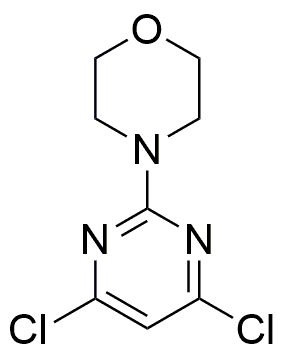4-(4,6-Dichloro-2-pyrimidyl)morpholine is widely utilized in research focused on:
- Pesticide Development: This compound serves as a key intermediate in the synthesis of various agrochemicals, particularly herbicides. Its unique structure allows for targeted action against specific weeds, improving crop yields.
- Pharmaceutical Research: It is explored for its potential as a pharmaceutical agent, particularly in the development of treatments for viral infections and certain cancers. Its efficacy in inhibiting specific biological pathways makes it a candidate for further study.
- Material Science: The compound is used in the formulation of advanced materials, including polymers and coatings, due to its stability and resistance to degradation. This enhances the durability of products in harsh environments.
- Biochemical Assays: In laboratory settings, it is employed as a reagent in biochemical assays to study enzyme activity and interactions, providing insights into metabolic pathways and disease mechanisms.
- Environmental Monitoring: The compound is also utilized in the detection and analysis of environmental pollutants, aiding in the assessment of soil and water quality, which is crucial for ecological health.
General Information
Properties
Safety and Regulations
Applications
4-(4,6-Dichloro-2-pyrimidyl)morpholine is widely utilized in research focused on:
- Pesticide Development: This compound serves as a key intermediate in the synthesis of various agrochemicals, particularly herbicides. Its unique structure allows for targeted action against specific weeds, improving crop yields.
- Pharmaceutical Research: It is explored for its potential as a pharmaceutical agent, particularly in the development of treatments for viral infections and certain cancers. Its efficacy in inhibiting specific biological pathways makes it a candidate for further study.
- Material Science: The compound is used in the formulation of advanced materials, including polymers and coatings, due to its stability and resistance to degradation. This enhances the durability of products in harsh environments.
- Biochemical Assays: In laboratory settings, it is employed as a reagent in biochemical assays to study enzyme activity and interactions, providing insights into metabolic pathways and disease mechanisms.
- Environmental Monitoring: The compound is also utilized in the detection and analysis of environmental pollutants, aiding in the assessment of soil and water quality, which is crucial for ecological health.
Documents
Safety Data Sheets (SDS)
The SDS provides comprehensive safety information on handling, storage, and disposal of the product.
Product Specification (PS)
The PS provides a comprehensive breakdown of the product’s properties, including chemical composition, physical state, purity, and storage requirements. It also details acceptable quality ranges and the product's intended applications.
Certificates of Analysis (COA)
Search for Certificates of Analysis (COA) by entering the products Lot Number. Lot and Batch Numbers can be found on a product’s label following the words ‘Lot’ or ‘Batch’.
Numéro de catalogue
Numéro de lot/série
Certificates Of Origin (COO)
This COO confirms the country where the product was manufactured, and also details the materials and components used in it and whether it is derived from natural, synthetic, or other specific sources. This certificate may be required for customs, trade, and regulatory compliance.
Numéro de catalogue
Numéro de lot/série
Safety Data Sheets (SDS)
The SDS provides comprehensive safety information on handling, storage, and disposal of the product.
DownloadProduct Specification (PS)
The PS provides a comprehensive breakdown of the product’s properties, including chemical composition, physical state, purity, and storage requirements. It also details acceptable quality ranges and the product's intended applications.
DownloadCertificates of Analysis (COA)
Search for Certificates of Analysis (COA) by entering the products Lot Number. Lot and Batch Numbers can be found on a product’s label following the words ‘Lot’ or ‘Batch’.
Numéro de catalogue
Numéro de lot/série
Certificates Of Origin (COO)
This COO confirms the country where the product was manufactured, and also details the materials and components used in it and whether it is derived from natural, synthetic, or other specific sources. This certificate may be required for customs, trade, and regulatory compliance.


